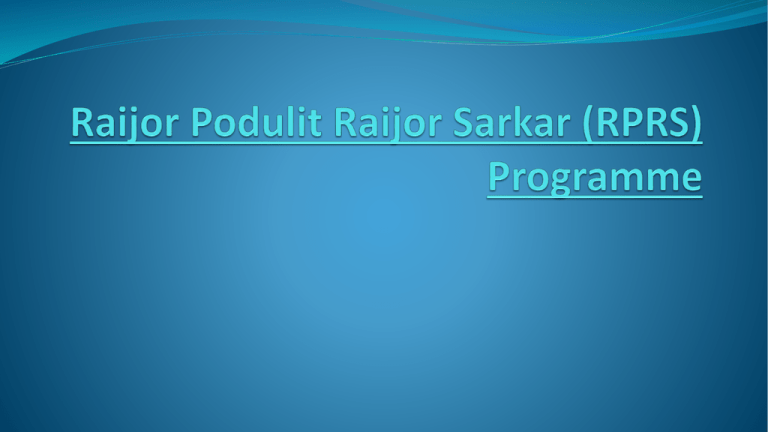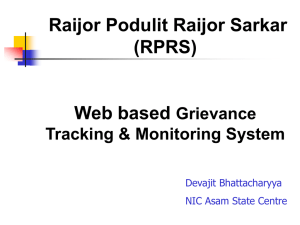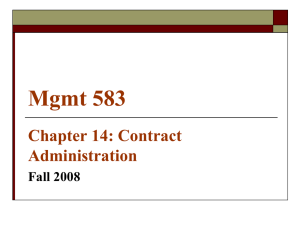Presentation - Panchayat & Rural Development Department, Assam
advertisement

Objectives To bring the government close to the people and to redress their grievances at their doorsteps Creation of Public Awareness about Govt. programmes Assess the local needs and infrastructural gap Identify the deficiency in Service Delivery System Based on RPRS outcome Govt. will take appropriate interventions to bridge the critical gap & improve the service delivery Nodal Department & Nodal Officers Panchayat & Rural Development Department will be the Nodal Department for coordination to implementing the Programme Commissioner, P&RD will be State Nodal Officer Each Department related to RPRS will designate one State Nodal Officer State Coordination and Monitoring Team Principal Secretary to CM – Chief Co-ordinator Principal Secretary, P&RD – Member Principal Secretary P&D - Member Principal Secretary, Finance – Member Commissioner, Panchayat & Rural Development(CPRD) – Member Secretary Sr. Most Secretary of Health & Family Welfare, Education, Public Health Engineering, Elementary Education, Food and Consumer’s Affairs, Labour and Employment, Handloom & Textile, Sericulture, Revenue and Disaster Management, PWD (R), Agriculture, Veterinary & Animal Husbandry, Fishery, Irrigation, Industries and Commerce. Departmental Coordination and Monitoring Team Each department will notify state level RPRS team Contact details of team will be intimated to State Nodal Officer Functions of the Departmental Coordination and Monitoring Team i. Preparation of Publicity & Public Awareness Material ii. Preparation of FAQ on departmental schemes iii. Preparation of formats for Gap Assessment of Public needs (Individual needs/ Community needs) iv. Preparation of formats to asses deficiencies in the Service Delivery System District Coordination and Monitoring Team There will be a District level Monitoring Team for RPRS consisting with the following officers: i. Deputy Commissioner/Principal Secretary, AC - Chairman ii. ADC( Public Grievances)/Project Director, DRDA – Member Secretary iii. Chief Executive Officer, ZP iv. District I/C of the concerned Department Team will be notified by the DC / Principal Secretary, AC Functions of the District Coordination and Monitoring Team i. ii. iii. iv. v. Organise training for the G.P. level RPRS teams as per the module. Keep proper records of the public grievances, suggestions, needs and critical gap assessed during the RPRS program Compile, analyze and redress the grievances. Compile and submit details of grievances to the concerned departments with intimation to Nodal Department for necessary action. The team will meet fortnightly to review the redressal of the public grievances or providing the facilities as requested by the people. Functions of the District Coordination and Monitoring Team (cont..) vi. Uploading and updating of data on RPRS MIS / Website. vii. All the members of the Committee shall attend RPRS Gram Sabha viii. Properly maintain records of expenditure for scrutiny and audit. ix. Start a RPRS whatsapp group for sharing information by the Stake holders. x. Share photographs and information regarding RPRS activities on WhatsApp group, Facebook and Twitter Methodology a) RPRS meeting will be arranged in the line of Gram Sabha in each GP/VCDC/VDC. The themes for RPRS 2015 Quarter 1st(January 2015) 2nd (April 2015) 3rd( July 2015) 4th( October 2015) Theme Health, Hygiene, Sanitation and Education Social Security & Women Empowerment Department Health & FW/Public Health Engineering/Social Welfare/ Elementary Education/P&RD Social Welfare/Food & Civil Supplies/P&RD/ Labour and Employment/Education/Handloom , Textile and Sericulture Land Revenue and Disaster Revenue and DM, Civil Defence, ASDMA, Fire and Management Emergency Rural Infrastructure, Livelihood Public Works Department/Public Health & Skills Engineering/P&RD (NRLM and SIRD), Labour and Employment (EGM)/ Industries and Commerce/ Agriculture/ Animal Husbandary & Veterinary/ Methodology b) RPRS program will be organized quarterly commencing from January, 2015. c) There will be one RPRS Team against each Gaon Panchayat consisting of the following members i. One representative from Deputy Commissioner/ Principal Secretary, Autonomous Council( Senior gazetted Officer) ii. G.P.Secretary/ Gram Sevak/ JE of P&RD Department iii. One woman representative (to be nominated by Deputy Commissioner/ Principal Secretary, Autonomous Council). iv. One officer from the department concerned. D.C./ Principal Secretary, AC will notify GP wise RPRS team and submit the list with Mobile Number of the members and e-mail id of team leader to State Nodal Officer Functions and Responsibilities of GP/VCDC/VDC level RPRS team i. ii. iii. iv. v. Preparation of an Action Plan for successful implementation of RPRS including arrangement of the meeting with the adult members of the Village/Villages. Publicity of the programme in the GP/VCDC/VDC area. Awareness about government’s developmental programme. Visiting the GP on the previous day of RPRS and stay in the night. Arrangement for night stay may be made by GP Secretary. Receiving the public grievance petitions. Functions and Responsibilities of GP/VCDC/VDC level RPRS team (cont..) vi. To dispose of petitions instantly where policy decisions or fund not required vii. Department wise classification and sorting of the public grievance petitions such as Individual needs and Community needs. viii. Inspection of Institutions/schemes of concerned Department. ix. Compilation of details of the outcome of the RPRS meeting and to submit the report to Deputy Commissioner/ Principal Secretary AC in prescribed format as shown in Annexure- I. x. Team will take photographs on arrival and during the programme and share them through whatsapp group administered by district level team Meeting of the R.P.R.S. Gram Sabha The meeting will be chaired by Senior most member of the PRI members present Agenda of the RPRS meeting 7.00 a.m.- Safai Abhijan at any public place with the help of local people 7:30 a.m.-10.30 a.m.- Inspection of Schools, Anganwadi Centres, Mini PHC, Hospitals, Subcentres Water Supplies Schemes, F.P. shop etc relevant to the theme 10.30 a.m. -11.00 a.m.- Reading out of CM’s Message 11.00 a.m. -1.00 p.m.- Interaction in Gram Sabha, Explaining Govt program to the people 1.00 p.m.-2.00 p.m.- Lunch break 2.00 p.m.-3.30 p.m.- Public Grievances- receipt of petitions and redressal Training and Orientation There will be a training cell at SIRD. Module for training will be prepared by the training cell ii. The Departments concerned will prepare a brief note on the guidelines of various schemes with FAQs, formats for gap assessment and submit the same to State Nodal Office(both in hard & Soft copies).Training cell will compile a Handbook for use by the GP level RPRS teams. iii. 4 (four) Master trainers from each districts will be trained by SIRD at State Level iv. The Master trainers will train the G.P. level teams in the district i. Role of Divisional Commissioner The Divisional Commissioner will supervise the effective and successful implementation of RPRS programme. ii. Review the preparedness of the districts for RPRS and also monitor the redressal of public grievances/ public and individual needs received during RPRS. iii. Also attend some RPRS Gram Sabha meetings and send his observations to the concerned D.C.s/Principal Secretaries, AC with copy to the Nodal Department of RPRS i. Documentation D.C. / Principal Secretary will arrange proper documentation of the RPRS exercise. A detailed report with photographs in the form of a booklet should be prepared after completion of each round of RPRS and be sent to Nodal department Publicity D.C./ Principal Secretary, AC will develop publicity materials Use TV, internet, mobile phone, print media hoarding, leaflets etc. for wide publicity. D.C/Principal Secretary will issue regular Press release and arrange Press Conference for awareness and wide participation of the people. A proper IEC plan may be prepared by them involving the DIPROs. State team will also arrange wide publicity about RPRS programme Grievance Application Form i. Public grievance can be submitted only in prescribed Application Form ii. The Application forms will be printed at District level iii. The Application form will be bi-lingual and will bear an eleven digit unique number. The first two digits will indicate district, the second two digits will indicate Block, third three digits will indicate G.P./VCDC/VDC and the last four digits will indicate application number. iv. The RPRS team will help the people to fill up the application form. v. In case there is shortage of printed form hand written application form may also be accepted. But it must be ensured that the unique number is correctly written on the top of the application with code given to Districts, Block, GP/VCDC/VDC vi. The applicant will be issued a receipt as printed below the Application Form MIS for RPRS There will be IT cell at State Level and also at District level for keeping track of all activities involved in the programme . NIC for develop of a software for this purpose. ii. A dedicated Website will be developed by State NIC for RPRS and all MIS & IT related activities will be integrate to the website. iii. District Coordination and Monitoring team will collect the report in annexure-I from G.P. level RPRS team and arrange to upload the same in RPRS application to be intimated separately. iv. All the complaints received from the RPRS programme will be analysed through computer applications at District and State level. i. MIS for RPRS v. Facebook and Twitter account will be maintained by State Team and photo, audio, video contents will be uploaded. vi. Whatsapp group will be started by State Team and all the DCs /Principal Secretaries AC. District and G.P. level RPRS team members will upload photographs on Whatsapp, Facebook and Twitter account on the day of RPRS and also during redressal of grievances. vii. Citizen will be provided a platform to share their views, comments and photographs on the RPRS Website Budget Fund for mobility, office expenses, publicity, documentation, data entry etc to be provided @Rs. 25,000.00 per quarter per G.P./VCDC. ii. Fund of Rs. 6.00 lakh to @ Rs. 50,000/- per month will be provided for State Nodal Office for office expense, computerization of data etc. iii. Additional fund of Rs. 15.00 lakh will also be provided for media campaign through Newspaper and TV at State Level iv. Total fund required is Rs. 26.88 crore i. Sample codes District: Block: VCDC: Code: District: Block: GP: Code: Baksa Baska Ambari 01 01 001 Barpeta Bajali Baghmara 02 01 001 Format for submission of summary of grievances DistrictBlockGP/VCDCDate of RPRS Gram SabhaSl. No of Name of Applicatio the n attached applican t Depart Type of ment to Grievances which relate Brief Action taken Action to be Action to be description of in the RPRS taken by taken by grievances Gram Sabha D.C./District State level line deptt authority Names and Sigatures of RPRS team Remarks Application form Serial number of Application Form (To be given by the RPRS team) Name of the Applicant: Father’s/Husband’s name: Name of the Village: Name of the GP/VCDC/VDC: Mobile Number of the applicant Name of the Grievance related Department: Name of the grievance related Scheme: Name of the Office against whom grievance / complaint submitted: Name and designation of the Officer/ staff against whom grievance / complaint given: Brief description of the Grievance: Signature of the applicant Acknowledgement Serial Number: Received the application from------------------------------------------------on ----------- Name and signature of the receiving officer. Thank you! Comments from DC Nalbari 1. DIO, NIC may be included in the District Level Coordination and Monitoring team. 2. Fund may be provided for the activities to be done at district level ; like a. Printing of application form. b. Training of GP level RPRS team. c. Publicity d. Maintenance of IT cell at district level. e. Printing of booklets, meetings etc. 3. Training may also be provided to Member- Secy. of District level Coordination and Monitoring Team. Comments from DC Golaghat From Deputy Commissioner, Golaghat, it is requested that in respect of point 9 ( C ) (1) of the draft guidelines for RPRS programme, the Circle Officer, considering their familiarity and better idea of local problems, issues etc. , be designated as DC’s representative since it will enable him to carry out his duties of revenue matter in the field. Comments from DC Chirang 1. In the State Coordination and Monitoring Committee, it would be better to include Social Welfare, Soil Conservation, Water Resources, I & PR and Home & Political Departments also to make it more representative as grievances in the field pertain to these departments as well. 2. A decision may be taken at State level to publish the material and conduct the publicity in three languages ie Assamese, Bengali and Bodo to have a greater reach among the public. 3. In the District level committee, it would be better to include SP and the respective DIOs of NIC. Comments from DC Chirang 4. The respective DIOs of NIC in the districts may be made nodal officer for all IT related tasks like uploading of reports, opening of FB, Twitter account and arranging for the software and hardware logistics and for rendering the technical support under the over all guidance of the district level committee. It will help in the optimum utilisation of the office of the DIO in the districts. 5. During the first quarter, " Nutritional Support " may also be included in the theme. similarly, for quarter 2 safety & security of the citizens may be included along-with the inclusion of Home deptt. The fourth quarter may also include Water Resources and Spoil Conservation deptts. 6. Provision can be made to include one more member from the same GP belonging to either SC/ST or physically challenged, if any. 7. The guidelines may include the modalities to deal with the delinquent officials in the district, RPRS team members who may not perform as per the guidelines. Comments from DC Chirang 7. The guidelines may include the modalities to deal with the delinquent officials in the district, RPRS team members who may not perform as per the guidelines. 8. Powers may be given to the District Level Committee to initiate action against the erring officials to make the programme more disciplined and focussed. 9. A time frame may be devised uniformly all across the State for redressal of grievances at district and state level for complaints being received related to various departments. 10. A token honorarium may be granted to the RPRS teams at GP/VCDC level. 11. A reward system may be introduced for the RPRS teams based on their performance to raise the motivation of the members. 12. Districts may also be given ranking based on the implementation of RPRS. 13. Last but not the least , all the line department officials may also be given clear directions and sensitization from the respective departments at State Headquarter.






